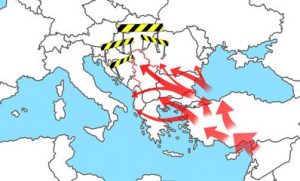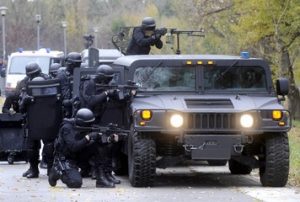Sarah Ní Mháirtín
2nd year ERI student majoring in Social Psychology:
As a student of the Ethnic Relations, Cultural Integration and Diversity (ERI) master’s program, my academic interest has typically been focused on migration; its history, its many forms and of course, its effects and consequences on sending countries, but more importantly, on receiving nations. This has typically been viewed through a social psychological lens on my part, with an emphasis on intergroup relations, integration and attitudes. Until enrolling in on particular class ‘Asylum mobility in the Mediterranean’, I had yet to conduct any in depth study of asylum seekers or refugees – although most people assume this is the sole focus of my degree. Those who don’t jump to the image of migrant smugglers and illegal entry imagine that I spend my time examining the flight pattern of birds when I mention that the focus of my master’s is migration studies! Mills (2016) also highlights this reaction (“migration studies – you mean like birds and stuff?”) and offers the explanation that in the eyes of the general public, the interchange of humans from one location to another evidently has yet to establish itself as a serious academic study.
The author of this International Migration Institute blog post suggests that these responses provide a lesser explored insight into public opinion of migration. Once the confusion over this field of study has been clarified, individuals typically assume that we focus on the macro figures and statistics; the number of people who have made the journey, how many have been separated from family along the way, injured or even been killed. As Mills so accurately states “not birds, but maybe still the bird’s-eye view”. This attention to the largescale highlights the degree to which “population” is entrenched in the public’s current mind set as a tangible phenomenon that can be observed, calculated and understood on a purely factual, quantitative basis. What is often forgotten is the individual behind the figures plastered on the headlines and the statistics that litter public discourse; a point also made by Vigani (2016) in her CEREN-ERI blog post. Beneath the numbers and macro data is individual human experience although they are often treated as an object of knowledge. I have noticed that each theme of this course contains an underlying message; that there is a need for a social scientific enquiry that examines areas outside of the usual security institutions, that provides a context without fear and creates a narrative of migrants’ entire experiences (and not just the part that immediately concerns Europe) to provide a more balanced understanding of current issues in migration.
Within this area of public opinion also arises the issue, who is a ‘refugee’? As discussed in class, during the Cold War a defector or refugee was seen as token in a war between hegemonies and used as a part of propaganda campaigns; proving that yours was the superior nation, because their enemy was considered to be your friend and by providing them with asylum you thus achieve a small victory over your opponent. Nowadays we typically view asylum seekers as those coming from conflict zones, forced from their homes because of war and the constant threat of immediate physical harm. According to the UNHCR (1951) a refugee is an individual who has a justifiable fear of being victimised because of their race, religion, nationality or membership of a particular social group/political opinion. But how do we view those fleeing from chaos, poverty or environmental crises?
Contemporary asylum seekers can fall into both categories; an escapee of a war zone and an economic migrant choosing to settle in more prosperous countries (typically further from the external borders of Europe) where they know they have a greater chance of finding work and getting some assistance from the state. Naturally, applying for residency solely on the basis of economic migration is problematic because Western, developed, industrialised countries are typically looking for highly skilled workers who will benefit their economy; if you’re economically marginal you will almost certainly not be permitted to migrate.
Thus, the refugee system fosters a system of cat and mouse between (in this context) European nations and those attempting to leave behind a life filled with extreme hardship. Although some have suggested a solution in the form of amending the terms of the UNHCR (1951) refugee treat, this is largely seen to be counterproductive as most nations will seize the opportunity to lessen their responsibilities toward asylum-seekers (Champion, 2015).
The public is becoming increasingly suspicious of asylum seekers following recent terrorist attacks in Europe (e.g. Paris, Brussels,). It is deemed difficult to determine whether migrants are really deserving of asylum or are in fact criminals or terrorists who plan to escape into the unregistered economy (Champion, 2015). This distrust and judgement over who is a ‘worthy’ asylum seeker can clearly be seen in the recent wave of migrants coming from the Calais ‘Jungle’ to the UK. Many have expressed serious objections to this movement on the grounds that most appear too old to be classified as ‘children’. Fear that migrants are in fact threatening ‘others’ with no respect or moral values also grows due to an exaggerated media focus on violence and crime. One extremely recent example is the rape of an interpreter in Calais, whose attackers have been portrayed as ‘alleged’ Afghan asylum seekers (e.g. RT, 2016), although this is just one of many similar reports. Although these claims are in fact valid, unfortunately all members of the ‘migrant’ or ‘asylum seeking’ group are then seen in the same light, adding fuel to extreme right wing protests against open borders and the granting of refugee status. As reported in the Telegraph (Dominiczak, 2016) David Davies, a UK Conservative MP states “I’m all for helping the genuine children but the well of goodwill is rapidly being exhausted here. There is no way of knowing if someone is a child. We could end up causing even more misery if we are not careful. We should invite anyone who wants to come to the UK to take dental tests.”
In my opinion, Davies’ statement perfectly sums up the concerns of anti-migrant groups and unfortunately, wider public opinion. A hierarchy of ‘deserving’ migrants is being created, meaning for example, that some who are not as knowledgeable of the necessary ‘criteria’ for asylum may be rejected, despite being just as ‘eligible’. Before long (as is happening at present) the fear spreads to nearly all asylum seekers who become categorised as terrorists, Islamic extremists or criminals. Who is considered a genuine asylum seeker and worthy of refugee status is becoming increasingly blurred and public opinion is becoming progressively more conservative and narrow minded. I fear that this attitude may define this period in time, one that future generations will look back on in disgust, unless we work towards positive, constructive change now.
Cover of book by Cambridge student Kate Milner which encourages young children to think about what it is like to flee home and journey into the unknown.
Photos provided by www.stock.adobe.com
References
Champion, M. (2015). Who counts as a refugee? Retrieved from https://www.bloomberg.com/view/articles/2015-06-26/who-counts-as-a-refugee-
Dominicak, P. (2016) “These don’t look like children to me”: concerns raised over ages of child refugees arriving in Britain. Retreived from
http://www.telegraph.co.uk/news/2016/10/17/from-the-calais-jungle-to-croydon-migrant-children-arrive-in-bri/
Mills, B. (2016). Common responses to the notion of Migration Studies. Retrieved from
https://www.imi.ox.ac.uk/blog/common-responses-to-the-notion-of-migration-studies
R.T. (2016). Interpreter raped by alleged Afghan migrants near Calais ‘Jungle’ camp. Retrieved from https://www.rt.com/news/363179-calais-interpreter-raped-migrants/
UNHCR (1951), Convention Relating to the Status of Refugees, 28 July 1951, United Nations, Treaty Series, vol. 189.
Vigani, A. (2016). Stuck in Athens: Staying human in the midst of the refugee crisis. A volunteer’s report. Retrieved from https://blogs.helsinki.fi/ceren-eri/2016/09/







